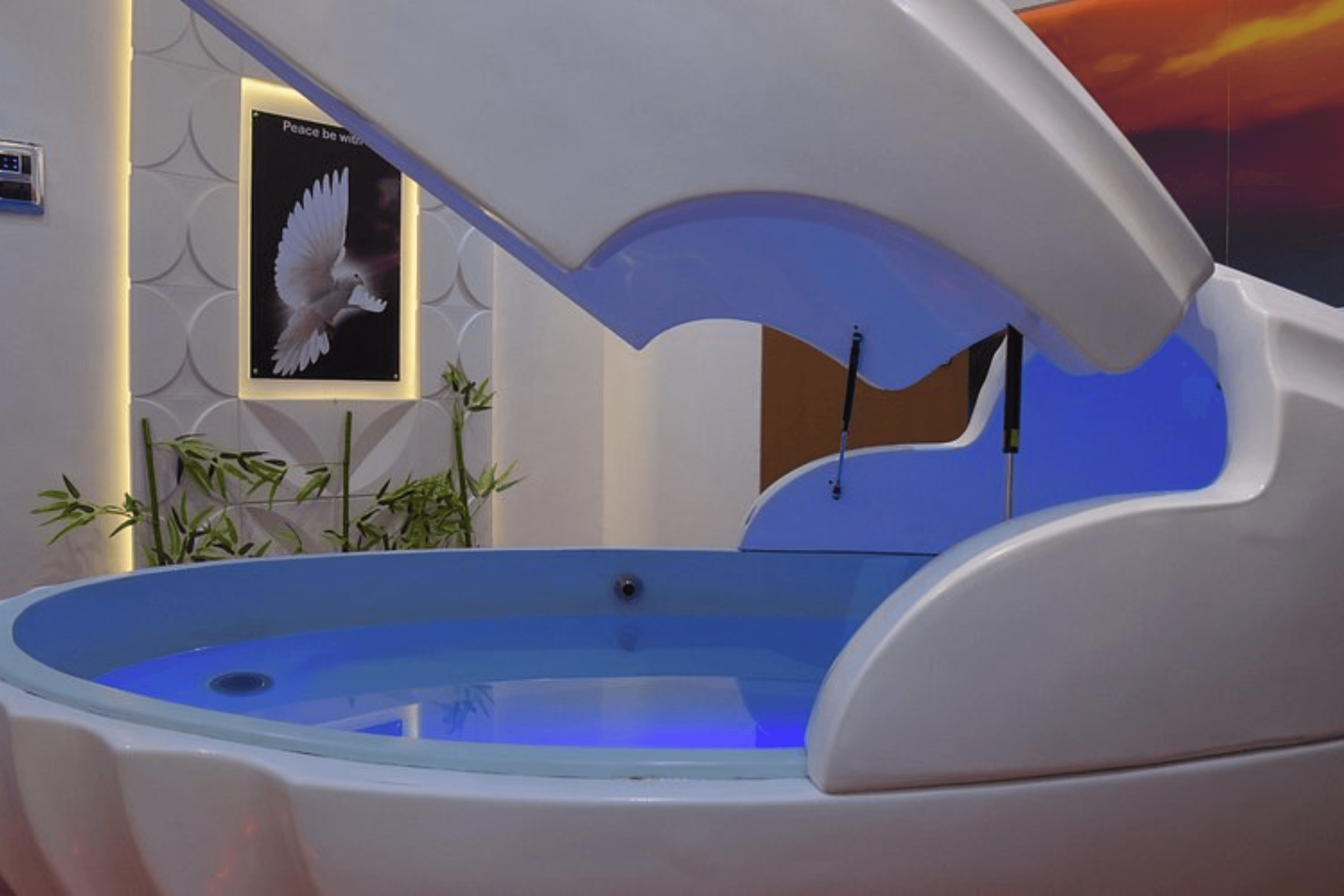Sensory overload is an unavoidable part of modern life—phones buzzing, screens glowing, traffic honking, and deadlines looming. In response, people are increasingly turning toward float therapy services and sensory deprivation tanks as a form of escape, healing, and mental clarity. But what exactly is the purpose of a sensory deprivation tank?
In this blog, we’ll explore the origins and evolution of sensory deprivation, the science behind its effects, and why float therapy sessions in these tanks have become a key pillar of holistic wellness. You’ll also discover how float session therapy can help regulate stress, heal the body, sharpen the mind, and deliver a wide array of long-term float session benefits
What Is a Sensory Deprivation Tank?
A sensory deprivation tank, also known as a float tank or isolation tank, is a lightproof, soundproof pod filled with warm water and Epsom salt. The high salt content allows users to float effortlessly on the surface. The water is maintained at skin temperature, and the environment is designed to eliminate external stimuli—including sound, light, gravity, and touch.
During float therapy sessions, users enter this tank to experience deep physical and mental relaxation. The tank creates a unique environment where the brain and body can reset—offering a rare opportunity for true stillness in today’s hyperactive world.
The Core Purpose of Sensory Deprivation
The sensory deprivation tank was not created merely for relaxation. It was invented in the 1950s by neuroscientist Dr. John C. Lilly to study consciousness and brain behavior in the absence of sensory input. Today, its purpose has evolved into a broad spectrum of wellness and therapeutic applications, such as:
1. Promoting Deep Relaxation
The primary goal of a sensory deprivation tank is to create an environment free of stimulation, allowing your nervous system to enter a deeply relaxed state. This can’t be achieved in traditional environments, no matter how comfortable your bed or spa might be.
2. Encouraging Mind-Body Connection
Float therapy sessions provide an opportunity to reconnect with your body, emotions, and thoughts without external distraction. This makes them valuable for meditation, reflection, and mental health support.
3. Supporting Physical Recovery
Athletes and people with chronic pain use float session therapy to relieve tension, inflammation, and soreness. The buoyant saltwater reduces pressure on joints, muscles, and the spine, helping the body recover more quickly.
4. Enhancing Mental Performance
The float tank allows the brain to switch to theta brainwave activity—associated with creativity, memory consolidation, and problem-solving. Many users report experiencing bursts of insight, vivid visualization, and enhanced focus after float therapy services.
Float Session Benefits Linked to Sensory Deprivation
Here are some of the most common and well-documented float session benefits that come from using sensory deprivation tanks:
- Reduced stress and anxiety
- Better emotional regulation
- Improved sleep quality
- Enhanced physical recovery
- Increased mental clarity and creativity
- Deeper meditative states
- Relief from chronic pain and inflammation
- Boosted immune function
The unique combination of silence, darkness, and weightlessness allows your body to rest and heal in ways it simply can’t elsewhere.
What Happens Inside the Tank?
A typical float therapy session lasts between 60 and 90 minutes. Here’s what happens during that time:
- Preparation: You shower to remove oils and products before entering the tank.
- The Float: Once inside, you lie back and float effortlessly in the saltwater.
- Relaxation: As external stimuli fade, your breathing slows, muscles release tension, and your mind begins to quiet.
- Integration: After your float, you may feel a sense of lightness, clarity, and calm that lasts for hours—or even days.
Many wellness centers offering float therapy services provide optional music or lighting controls for first-time users. However, most experienced floaters prefer complete silence and darkness to maximize the float session benefits.
Scientific Purpose and Evidence
1. Stress Hormone Reduction
Studies have shown that float therapy sessions lower cortisol levels—the hormone associated with stress. Lower cortisol = improved mood, sleep, and overall well-being.
2. Mental Health Support
Research from Sweden and the United States has confirmed that regular use of sensory deprivation tanks can reduce anxiety, symptoms of PTSD, and depression, making float session therapy an effective supplement to traditional mental health treatments.
3. Improved Creativity and Brain Function
Floating triggers theta wave activity—similar to deep meditation. This state supports creativity, problem-solving, and mental clarity. Artists, musicians, and entrepreneurs often turn to float therapy services to unlock new ideas and insights.
Why the Tank Environment Matters
The sensory deprivation tank isn’t just a fancy tub. Its very design supports healing and transformation. Here’s how:
| Tank Feature | Purpose/Effect |
| Saltwater Buoyancy | Eases joint pressure, improves circulation |
| Darkness | Reduces visual stimulation, calms the mind |
| Silence | Eliminates auditory stress, encourages inward focus |
| Skin-temperature water | Disappears from awareness, enhancing sensory detachment |
| Enclosed space (optional) | Promotes deep immersion in the floating experience |
Together, these features allow float therapy sessions to deliver full-body and full-mind relief, especially for people with sensory sensitivity, trauma, or high stress levels.
Who Can Benefit from Sensory Deprivation Tanks?
The float session benefits appeal to a wide audience, including:
- Burned-out professionals
- Overstimulated creatives
- Athletes and gym-goers
- People with anxiety, PTSD, or insomnia
- Chronic pain sufferers
- Pregnant women (second and third trimester)
If your lifestyle involves pressure, overthinking, or physical tension, float therapy services can help bring balance back to your system.
Is It Safe and Comfortable?
Yes. Most users describe their first float therapy session as “strange but soothing.” You remain in control at all times—able to exit the tank when needed. The experience is highly customizable, and facilities offering float therapy services often have staff to guide first-timers.
Precautions:
- Avoid shaving or waxing before floating (salt can irritate skin)
- Don’t float with open wounds or infections
- Check with your doctor if you have epilepsy, heart conditions, or are pregnant
FAQs About Sensory Deprivation Tanks
Q1: Is the tank claustrophobic?
Surprisingly, no. Most tanks are spacious enough to stretch out in. You can float with the lid open or closed, and lights can be adjusted for comfort during float therapy sessions.
Q2: Will I fall asleep or drown?
It’s common to fall asleep, but the high salt content keeps you afloat safely. Drowning is virtually impossible in a properly maintained tank.
Q3: How clean are float tanks?
Very. Float therapy services providers follow strict sanitation protocols, filtering and disinfecting the water after every session.
Q4: Do I need to prepare before a float session?
Just avoid caffeine, alcohol, and heavy meals beforehand. Showering before and after the float is standard at all reputable float therapy services locations.
Q5: Can I bring music or guided meditation into the tank?
Yes, many facilities offer optional in-tank audio. However, most advanced users prefer silence to maximize float session benefits.
Conclusion: The Deeper Purpose of Floating
The purpose of a sensory deprivation tank goes far beyond mere relaxation—it is about restoration, healing, and transformation. Whether you’re dealing with stress, injury, overthinking, or just modern life’s constant stimulation, float therapy services provide a powerful tool to reset your nervous system and reconnect with your inner calm.
Through silence, stillness, and saltwater, float therapy sessions strip away the noise of life, leaving clarity, peace, and healing in their place. That is the true essence—and purpose—of float session therapy.






